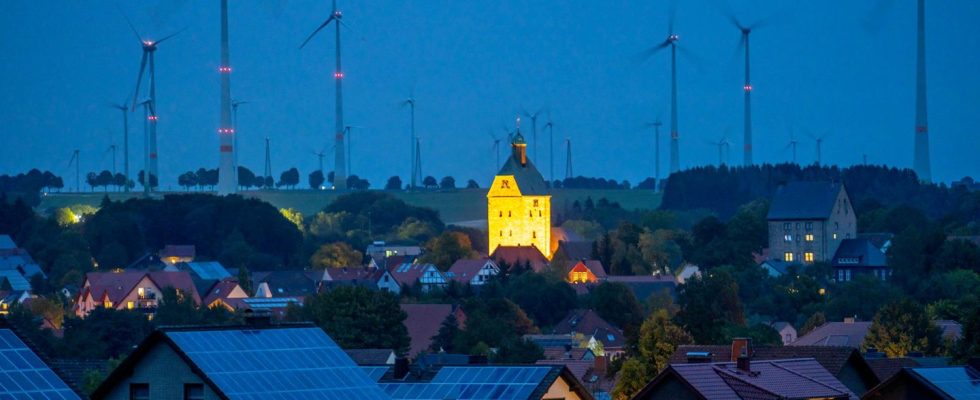column
Interactive map
We need more energy from sun and wind – not just to protect the climate
The town of Lichtenau near Paderborn calls itself an energy city. The more than 170 wind turbines produce nine times as much electricity as the 11,000 residents consume. Many roofs of private and commercial buildings also have solar modules.
© IMAGO/Jochen Tack
Germany should be climate neutral by 2045. Of course, this can only be achieved with a massive expansion of renewable energies. In some places this works well, but in other areas it doesn’t work at all. How come?
For the expansion of electricity generation from renewable sources, there are clear guidelines as to when and by what increases in the individual sectors are necessary in order to achieve the goals. But depending on the sector, there are more or less large gaps between desire (or political requirement) and reality.
Expansion of renewable energies
Solar energy and wind power are the two most important pillars in renewable energy production. And Germany is also on track when it comes to expanding solar power, but is lagging behind the targets when it comes to expanding wind power.
The expansion of solar energy is progressing very well. Solar panels are becoming more and more common on the roofs of private and company buildings, on public buildings and even open spaces. The reason for this is that the modules are currently available quite cheaply due to overproduction in China. Even smaller solutions such as so-called balcony power plants seem to be useful to many citizens in order to reduce their own electricity bills. The graphic above shows the current status of the expansion in comparison to the federal government’s specifications. Germany is clearly on track for solar power. If as many new solar power systems continue to be installed in the coming years as currently, the goal of 400 gigawatts of solar power by 2040 seems quite realistic.
However, the situation is completely different with wind energy. Chancellor Olaf Scholz has announced several times that four to five wind turbines must and should be set up every day. This is the only way to succeed in doubling onshore wind power by 2030 Renewable Energy Act EEG23 prescribes.
But in fact, in the first half of 2023, an average of just two systems were built per day. The wind energy graphic therefore shows a clear downward trend and clearly misses the political target. Apparently the legal requirement from the Federal Ministry of Economics has not changed this, according to which every federal state must reserve two percent of its area for the expansion of wind energy.
Climate protection versus environmental protection
The lengthy and complex procedures that precede installation still prove to be immense obstacles. On average, it takes four to five years for a new wind turbine to be planned and approved. The often massive resistance of some local people does the rest. Whether it’s birds of prey or bats: those involved often prioritize nature protection over climate protection. “In some cases, climate protection goals conflict with environmental protection goals. However, that is no justification for playing the two topics off against each other. On the contrary: we always have to think about them together,” says Cedric Carr, psychology student and project manager at the Klimadashboard association. The association visualizes facts and figures about the causes and consequences of climate change (Klimadashboard.de).
Interestingly, the majority of German citizens support the expansion of renewable energies. According to a recent study, 82 percent support him. Even in Bavaria, which is clearly lagging behind in the expansion of wind energy, the population’s approval is high. “It’s not the social will that’s missing, it’s the political will,” says Carr. The lobby of some large corporations from the coal industry is also delaying the conversion.
Meanwhile, Carr does not accept the often-mentioned argument that wind turbines would “spareize” the beautiful landscape: “I recommend everyone to take a trip to the largest hole in Europe, the brown coal open-cast mine in the Ruhr area. There you can see how fossil energy production is destroying the landscape on a large scale.” Especially since lignite and hard coal not only cause visual damage, but their combustion also seriously harms people’s health. “The climate crisis is also a health crisis. Almost all German citizens are exposed to the danger of fine dust, which is sometimes created when coal is burned,” says Cedric Carr. More than 10,000 deaths per year in Germany are caused by combustion residues. The use of renewable energies would also contribute to protecting health. “But many opponents of wind energy are not aware of this,” says Carr.



